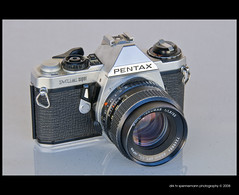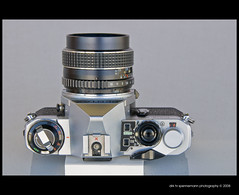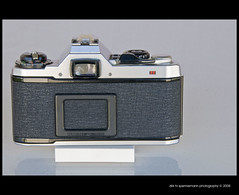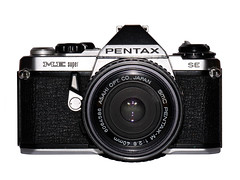Difference between revisions of "Pentax ME Super"
(Corrected code for image in Infobox) |
(eyepiece, height change, flash & selftimer details, prose tweaks) |
||
| Line 25: | Line 25: | ||
}} | }} | ||
| − | In 1977, [[Pentax]] | + | In 1977, [[Pentax]] introduced two compact 35mm [[SLR]]s, the [[Pentax MX|MX]] and the [[Pentax ME|ME]]. These followed a trend towards smaller size in SLR cameras inspired by 1972's [[Olympus OM-1]]. |
| + | |||
| + | Of the pair, the [[Pentax ME|ME]] was the autoexposure model, but it lacked any manual shutter-speed settings. In 1979 Pentax replaced the original ME with the simpler [[Pentax MV|MV]] and the more advanced '''ME Super''', which had the following changes: | ||
| − | |||
* manual mode added | * manual mode added | ||
* shutter speed range from 4s to 1/2000, sync at 1/125 | * shutter speed range from 4s to 1/2000, sync at 1/125 | ||
* additional [[hot shoe|shoe]] contact for dedicated Pentax flash units | * additional [[hot shoe|shoe]] contact for dedicated Pentax flash units | ||
| − | * | + | * -1.0 diopter eyepiece (changed from -0.5) |
* The marking "ASAHI" in the pentaprism housing was eliminated sometime between the ME and the ME Super | * The marking "ASAHI" in the pentaprism housing was eliminated sometime between the ME and the ME Super | ||
| − | The Pentax ME Super | + | The "Super" version is also a fraction of a millimeter taller than the original ME, although the difference is imperceptible in use. |
| + | |||
| + | The Pentax ME Super is an [[aperture priority]] automatic camera, with a [[focal plane shutter]] electronically timed from 4s to 1/2000, and with [[flash sync]] at 1/125. The shutter uses vertically-traveling metal curtains. For manual mode the ME Super uses two buttons, up and down, to select the shutter speed, rather than a more conventional rotary dial. The [[light meter|exposure meter]] was of the standard [[TTL]] open aperture center-weighted type. It was activated by a slight pressure on the release button. | ||
| − | The Pentax ME Super | + | The Pentax ME Super has a 0.95x viewfinder, covering 92% of the field. The finder screen is fixed, with a [[Split-image device|split image]] and a [[microprism]] ring in the center. The shutter speed chosen by the camera or the user is displayed in the finder, although aperture is not. |
| − | + | The ME has a mechanical self-timer with a maximum delay of about 10 seconds. After setting, the self-timer lever must be nudged clockwise again to begin the countdown. The camera has a [[hot shoe]] with an additional contact. Dedicated Pentax flash units use this to communicate a flash-ready indicator in the viewfinder and to automatically select the correct 1/125 sec. shutter speed, overriding any manual or auto setting. The selector around the release button had five positions: L (lock), Auto, M (manual), 125X and B. The Pentax ME Super can accept either the external ''winder ME'' (1.5 i/s) or the later ''Winder ME II'' (2i/s). The Pentax ME Super can also mount a ''Dial Data ME'' databack, or the later ''Digital Data M'' databack via a cord adapter. | |
| − | + | Interchangeable lenses for the ME Super use the [[K mount lenses|K bayonet mount]]. The SMC Pentax-M lenses were a more compact K-mount series introduced alongside the ME and MX cameras. | |
| − | The Pentax ME Super | + | The Pentax ME Super exists in chrome or black finish. There is a special edition called '''ME Super SE''', only sold in chrome finish; the differences are the ''SE'' marking and the diagonal instead of horizontal split-image device in the focusing screen.<REF> [http://www.bdimitrov.de/kmp/bodies/film_M/ME_Super.html ME Super page] by Bojidar Dimitrov. </REF> |
A derivative with a primitive autofocus mechanism, called the [[Pentax ME-F]], was released in 1981. Production of the ME Super stopped in 1986. | A derivative with a primitive autofocus mechanism, called the [[Pentax ME-F]], was released in 1981. Production of the ME Super stopped in 1986. | ||
Revision as of 18:09, 16 August 2015
| Pentax ME Super |
|---|
|
Maker: Pentax Dates: 1980-1986 Variants: chrome, black, SE Camera Type: 35mm SLR Focusing: manual Lens mount: Pentax K with fully automatic diaphragm linkage Shutter: SEIKO MFC-E2 electronic focal plane, vertical, metal Exposure meter: TTL, open aperture, Exposure modes: aperture priority, manual, 125 mechanical, Bulb ASA/ISO range: 12 to 1600 ISO Finder screen: fixed split-screen Flash shoe: fixed hot shoe, contact for dedicated flash Flash speed: 1/125 TTL Flash: no Motor drive: external Winder ME (1.5i/s) or Winder ME II (2i/s) Battery: 2 × 1.5V (SR44, LR44 or equivalent) Weight: 445g w/o lens Number produced: unknown |
In 1977, Pentax introduced two compact 35mm SLRs, the MX and the ME. These followed a trend towards smaller size in SLR cameras inspired by 1972's Olympus OM-1.
Of the pair, the ME was the autoexposure model, but it lacked any manual shutter-speed settings. In 1979 Pentax replaced the original ME with the simpler MV and the more advanced ME Super, which had the following changes:
- manual mode added
- shutter speed range from 4s to 1/2000, sync at 1/125
- additional shoe contact for dedicated Pentax flash units
- -1.0 diopter eyepiece (changed from -0.5)
- The marking "ASAHI" in the pentaprism housing was eliminated sometime between the ME and the ME Super
The "Super" version is also a fraction of a millimeter taller than the original ME, although the difference is imperceptible in use.
The Pentax ME Super is an aperture priority automatic camera, with a focal plane shutter electronically timed from 4s to 1/2000, and with flash sync at 1/125. The shutter uses vertically-traveling metal curtains. For manual mode the ME Super uses two buttons, up and down, to select the shutter speed, rather than a more conventional rotary dial. The exposure meter was of the standard TTL open aperture center-weighted type. It was activated by a slight pressure on the release button.
The Pentax ME Super has a 0.95x viewfinder, covering 92% of the field. The finder screen is fixed, with a split image and a microprism ring in the center. The shutter speed chosen by the camera or the user is displayed in the finder, although aperture is not.
The ME has a mechanical self-timer with a maximum delay of about 10 seconds. After setting, the self-timer lever must be nudged clockwise again to begin the countdown. The camera has a hot shoe with an additional contact. Dedicated Pentax flash units use this to communicate a flash-ready indicator in the viewfinder and to automatically select the correct 1/125 sec. shutter speed, overriding any manual or auto setting. The selector around the release button had five positions: L (lock), Auto, M (manual), 125X and B. The Pentax ME Super can accept either the external winder ME (1.5 i/s) or the later Winder ME II (2i/s). The Pentax ME Super can also mount a Dial Data ME databack, or the later Digital Data M databack via a cord adapter.
Interchangeable lenses for the ME Super use the K bayonet mount. The SMC Pentax-M lenses were a more compact K-mount series introduced alongside the ME and MX cameras.
The Pentax ME Super exists in chrome or black finish. There is a special edition called ME Super SE, only sold in chrome finish; the differences are the SE marking and the diagonal instead of horizontal split-image device in the focusing screen.[1]
A derivative with a primitive autofocus mechanism, called the Pentax ME-F, was released in 1981. Production of the ME Super stopped in 1986.

|

|

|
|
images by Dirk HR Spennemann (Image rights) | ||
Notes
- ↑ ME Super page by Bojidar Dimitrov.
Links

|
| ME Super SE image by wolf4max (Image rights) |
- User's manual at Pentax Imaging
- The Pentax M series at krg site
- Pentax ME Super Ramblings
- Bojidar Dimitrov's Pentax K-mount site
- The ME Super at Aya's Cameras
- ME Super and french user manual on www.collection-appareils.fr by Sylvain Halgand
- Pentax-Manuals.com Manual for the Pentax Manual Focus cameras
| Pentax K mount SLR Cameras |
|---|
| K2 | KX | KM | K1000 | MX | ME | ME Super | ME-F | MV | MV1 | MG | LX | Super-A | Program-A | A3 | P30| P30n/P3n/P30t | P50 | SFX/SF1 | SF7/SF10 | SFXn/SF1n | Z-1/PZ-1 | Z-10/PZ-10 | Z-20/PZ-20 | Z-50p | Z-5 | Z-5p | Z-70/PZ-70 | Z-1p/PZ-1p | MZ-5/ZX-5 | MZ-3/ZX-3 | MZ-5N/ZX-5N | MZ-7/ZX-7 | MZ-6/ZX-L | MZ-S | MZ-10/ZX-10 | MZ-50/ZX-50 | MZ-30/ZX-30 | MZ-60/ZX-60 | Pentax *ist | MZ-M/ZX-M |
